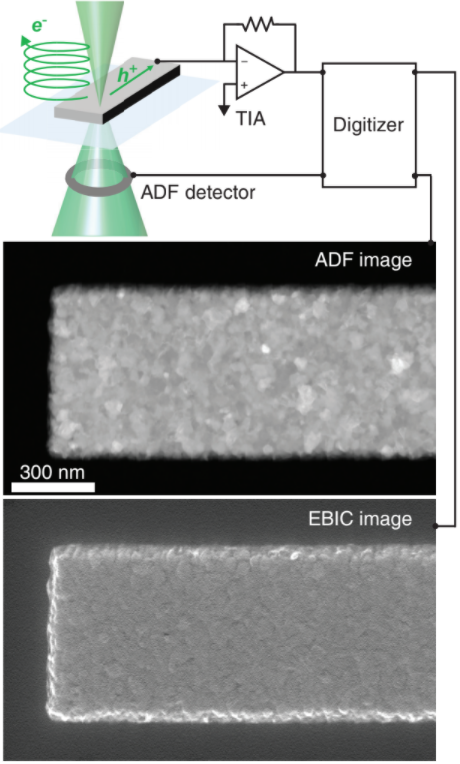=================================================================================
Electron beam induced current (EBIC) was the first application of charging-induced effects in SEM and STEM. In this EBIC technique, a focused electron beam is scanned across a sample that is attached to a transimpedance amplifier (TIA) as shown in Figure 3831. Then, associating the measured sample current with the beam position forms the EBIC image.

Figure 3831. STEM EBIC imaging of a metal electrode. (top) Schematic of the basic EBIC setup, (middle) ADF STEM image, (bottom) EBIC image. [3]
|
Because one primary electron can create thousands of electron-hole pairs, this generated current is formed by the separation of electron-hole pairs excited by a high energy e-beam (electron-beam) irradiating on semiconductor devices. For instance, the distinction at cross-sectional surfaces between n- and n+ regions was observed on a Si (silicon) wafer [1]. EBIC measurements demonstrated that shallow states exist at Σ3 coincidence site lattice (CSL) grain boundaries. [2]
EBIC imaging has many applications of mapping:
i) PFA failure
ii) Electric fields, e.g. in Si-dislocation defects
iii) Carrier lifetimes
iv) Diffusion lengths
v) Defect energy levels
vi) Surface recombination velocities
[1] Kato, T., Matsukawa, T., Koyama, H., Fujikawa, K. and Shimizu, R.
(1975) Scanning electron microscopy of charging effect on silicon. J. Appl.
Phys., 46, 2288 - 2292.
[2] A. Buis, Y. S. Oei and F. W. C. Schapink: Trans. Japan Inst. Metals
Suppl. 27 (1986) 221–228.
[3] William A. Hubbard, Matthew Mecklenburg, Ho Leung Chan, and B. C. Regan, STEM Imaging with Beam-Induced Hole and Secondary Electron Currents, Physical Review Applied 10, 044066 (2018).
|